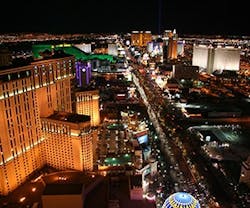On a recent flight to Las Vegas, I emerged from the plane into a local temperature of 101 degrees F. and 5% humidity. The following week, I flew to the Philippines, where I stepped into temperatures in Manila that ranged from 85 to 95 degrees F., but the humidity was typically 80%. While Las Vegas and Manila share extreme conditions, their approaches to energy management are different.
In Vegas, I spent most of my time in large hotels. In these buildings, luxury and comfort are the goals and energy efficiency has been a lower priority. When I opened the door to my hotel room, I discovered incandescent lights left on to enhance the guest’s first impression.
Despite an unwillingness to sacrifice comfort, many buildings in Las Vegas are undertaking large retrofit projects that not only improve their energy bottom line but also drive new technology from manufacturers. For example, when a major property chain with multiple properties updates to LEDs, it can buy as many as 100,000 lamps to satisfy guest room requirements alone. That purchasing power is significant, and it can drive research and design from lighting manufacturers.
For example, a large hotel chain recently made a deal to purchase a new LED with “candlelight ambiance” for its chandeliers. The replacement lamp has a visually appealing design and 1800K color temperature. Given the high volume, the manufacturer can afford to invest in the design of a new product, one that will eventually be available for your buildings. Similar HVAC developments are underway in Las Vegas. If these can work with the city’s extreme climate and its demands for plentiful ventilation and pleasing aesthetics, they can probably work for your buildings.PageBreak
Comfort Sacrifices in Southeast Asia
In Manila the approach to comfort is radically different. Although downtown Manila’s hotels and casinos have high-end occupant space with class A expectations, building designers and managers place a heavy focus on conservation. In particular, they are willing to make some sacrifices to comfort. They provide air conditioning but only where it is critical.
Given Manila’s humidity, air conditioning is a lifeline for business travelers – especially those wearing a suit and tie. Taxi cabs market if they have “AirCon,” but you cannot expect an entire building to have it. In fact, most buildings provide air conditioning only to individual office rooms, not to common spaces like lobbies, corridors, elevators, or bathrooms, which are typically located within the unconditioned central elevator shaft areas. In shopping malls, only individual stores are likely to have air conditioning, not common areas.
In Manila, energy costs are a relatively expensive 25 cents per kWh, which is a factor driving the conservation approach. However, I have seen similar attitudes across Southeast Asia, even where energy costs are lower. Buildings in Hong Kong, Singapore, Guangzhou, Taiwan, and Shanghai are designed and operated in much the same way, even though energy costs are closer to 10 cents per kWh in those cities.
My experience in hotels across Southeast Asia is that electricity is only distributed to rooms when the guest is present. Occupancy sensors or card keys inserted into a slot are used to control air conditioning, lights, TV, fans, and outlets. This solution has saved billions of dollars in energy waste. In addition, most buildings have already implemented LED lighting for many applications, reducing direct electrical costs, as well as the associated heat load that lighting systems have on air conditioning systems. In Southeast Asia, where there is no winter and many buildings have no heating system, air conditioning demands are nearly year-round. As a result, the HVAC savings from cooler lighting is greater than it would be in colder climates.
The Southeast Asian “conservation with sacrifice” approach has also influenced public policy. For example, over the past 5 years, temperature setpoints have been raised in government buildings. In exchange for higher temperatures and smaller comfort, occupants – including government leaders – are encouraged to omit neckties, even in formal settings. I have found that when government implements such policies, the private sector follows, making it the new norm.
At the conference I attended in Manila, I was wearing a tie in a building with a setpoint of 80 degrees F. After staring at me for a bit and feeling sorry for me, other attendees told me that they have removed the tie requirement from a business meeting although they still wear suits.
It took me some time to get accustomed to unconditioned building areas, but I did. And I immediately liked the idea of getting rid of ties.
What would happen if you proposed a “no necktie” policy for your building? And what other tradeoffs can you make to save energy during the peak summer season?
